Overview
- Brief Narrative
- Scrip, valued at 10 kronen, distributed to Selma Ansbacher and her family in Theresienstadt ghetto-labor camp in German-occupied Czechoslovakia between May 1943 and May 1945. At Theresienstadt, currency was confiscated from inmates and replaced with scrip, which could only be used in the camp. Before the war, Selma’s husband, Ludwig Ansbacher, owned a fabric store in the small town of Dinkelsbühl, Germany. In 1937 they moved to Frankfurt. They sent their oldest son Manfred to an agricultural school near Hanover and he immigrated to Australia by 1939. In May 1942, their son Heinz was deported to Majdanek killing center in German-occupied Poland and was killed in August. Selma, Ludwig, and their daughter Sigrid were deported to Theresienstadt ghetto-labor camp in German-occupied Czechoslovakia in September 1942. Initially, Selma worked as a group leader in the kitchen, peeling potatoes for soups. She later worked in the mica-splitting facility, a job that contributed to the war effort, which she tried to use as leverage when Sigrid was assigned to a transport out of Theresienstadt. In 1944, Sigrid was deported to a number of concentration camps, including Auschwitz in German-occupied Poland and Bergen-Belsen in Germany, where she was liberated by British forces on April 15, 1945. Selma and Ludwig remained at Theresienstadt until the Soviet Army liberated the camp on May 9, 1945. The couple moved back to Frankfurt before immigrating to the United States in July 1946, where Sigrid joined them the following December.
- Date
-
use:
after 1943 May-before 1945 May 09
publication: 1943 January 01
- Geography
-
issue:
Theresienstadt (Concentration camp);
Terezin (Ustecky kraj, Czech Republic)
- Credit Line
- United States Holocaust Memorial Museum Collection, Gift of Sigrid Jean Ansbacher Strauss
- Markings
- face, center, printed, navy blue ink : QUITTUNG ÜBER / ZEHN KRONEN / 10 / WER DIESE QUITTUNG VERFÄLSCHT ODER NACHMACHT / ODER GEFÄLSCHTE QUITTUNGEN IN VERKEHR BRINGT, / WIRD STRENGSTENS BESTRAFT. [RECEIPT OF / TEN CROWNS / 10 / ANYONE WHO FALSIFIES OR DISTORTS OR FAKES THIS RECEIPT, OR COUNTERFEITS RECEIPT, WILL BE STRICTLY PUNISHED]
face, lower right corner, printed, navy blue ink : 10
reverse, upper left corner, plate letter and number, printed, navy blue ink : A021
reverse, upper right and lower left corners, printed, navy blue ink : 10
reverse, center, printed, navy blue ink : Quittung / über / ZEHN KRONEN / THERESIENSTADT, AM 1.JÄNNER 1943 DER ALTESTE DER JUDEN / IN THERESIENSTADT / Jakob Edelstein [Receipt / of / TEN CROWNS / THERESIENSTADT, ON 1. JANUARY 1943 THE ELDER OF THE JEWS IN THERESIENSTADT Jakob Edelstein] - Contributor
-
Subject:
Selma Ansbacher
Designer: Peter Kien
Printer: National Bank of Prague
Issuer: Der Alteste der Juden in Theresienstadt
- Biography
-
Selma Ansbacher (nee Schlossberger, 1897-1956) was born in Wachbach, Germany to Bertha Schlossberger (nee Strauss, 1864-1936) and Sigmund Schlossberger (1863-1942, died from chronic illness). She had four siblings: Palma (1894-?), Josef (1899-?), Hedwig (later Holzer, 1903-1995), and Gisela (later Levi, later Feuchtwanger, 1906-2003). In 1921, at 24 years old, she married Ludwig Ansbacher (1888-1950), a veteran of the German army in World War I. Ludwig lost an eye during the war and was awarded the Iron Cross for his service. Initially he worked in the family business as a cattle dealer and later ran a fabric store. The couple had three children: Manfred (1922-2012), Heinz (1925-1942), and Sigrid (b. 1928).
The family lived in Dinkelsbühl, Germany, in an apartment above Ludwig’s fabric store. Hitler came to power in 1933 and Ludwig was forced to close his store after the Nuremberg Laws were passed in 1935. He then began to work as a traveling fabric salesman, riding his bike into the countryside to sell to farmers. The family attended an Orthodox synagogue, and had many good friends that were non-Jewish. However, those relationships changed as anti-Semitism increased. In 1936, Manfred was sent by his parents to an agricultural school near Hanover; by 1939, he immigrated to Australia, changed his surname to Anson, and eventually joined the Australian army. In 1937, anti-semitism in the small town had grown so much that the family decided to re-locate to Frankfurt, joining extended family. The Ansbacher family did not live in Frankfurt’s central Jewish neighborhood, and therefore avoided the vandalism and damaged stores of the Kristallnacht attacks on November 9-10, 1938. The following day, however, the SS arrested Ludwig, sending him and 10,000 other Jews to Buchenwald concentration camp, where they received extremely cruel treatment. Ludwig was sent home after 2-3 weeks and Selma attempted to obtain paperwork for the family to immigrate to America. The United States had a quota system for German immigrants, and the Ansbachers’ numbers were too high to make immigration an option.
In May 1942, 17-year-old Heinz was assigned to a transport, and the rest of the family volunteered to go with him. Heinz was separated out at the collection center; the guards prevented the rest of the family from getting on the transport and they were sent home, perhaps due to Ludwig’s military service. Heinz died on August 1, 1942 at Majdanek killing center in German-occupied Poland. Sigrid later credited her father’s war injury with the rest of the family being sent to Theresienstadt ghetto-labor camp in German-occupied Czechoslovakia. They were deported as part of Transport XII/3 on September 15, 1942. Selma and Ludwig were assigned to a group house while Sigrid was assigned to a children’s home a few blocks away. Initially, Selma worked as a group leader in the kitchen, peeling potatoes for soups. She became known as the “Potato Queen,” letting the women go each day without checking pockets, allowing them to take home potatoes to supplement the meager rations. This was a big risk as it was against the ghetto rules. If Selma had been caught, she probably would not have survived. Later, she was reassigned to work in a factory that split mica for industrial applications, contributing to the war effort.
In October 1944, at age 16, Sigrid was assigned to a transport out of Theresienstadt. Selma wrote a letter to the Central Secretariat, begging him to keep Sigrid off the transport. Her plea went unheeded, and Sigrid was deported to a number of concentration camps, including: Auschwitz in German-occupied Poland, Kurzbach and Gross-Rosen in Germany, Mauthausen in Austria, and Bergen-Belsen in Germany, where she was liberated by British forces on April 15, 1945. Germany surrendered on May 7. Sigrid volunteered to be part of a contingent to travel on a ship to a Swedish hospital on July 26.
Selma and Ludwig continued to live at Theresienstadt until the Soviet Army liberated the camp on May 9, 1945. The couple later moved back to Frankfurt. They were notified about Sigrid’s survival by a letter from Ludwig’s brother in Boston. The postal system was fractured after the war, but the family was finally able to exchange letters and Selma kept everything her daughter wrote. Selma and Ludwig immigrated to the United States in July 1946 and settled in New York City. They met Sigrid on the dock when she arrived in New York in December. Sigrid married Fred Strauss (1926-2013), another refugee, in September 1948 and had two children. Manfred Ansbacher immigrated to the United States in 1961.
Franz Peter Kien was born January 1, 1919, in Varnsdorf, Czechoslovakia (Czech Republic), to Leonard and Olga Frankl Kien. His father Leonard was born in 1886, in Varnsdorf, and was a member of the German-speaking Jewish population in the, the Sudetenalnd, which bordered Germany. Leonard was a textile manufacturer with his own factory. Peter’s mother Olga was born in 1898, in Bzenec, Austro-Hungary (Czech Republic), to Jewish parents. After 1929, the Kien family moved to Brno. Peter enrolled at the German Gymnasium, where he excelled at drawing, painting, and writing. In 1936, he graduated and moved to Prague to study at the Academy of Fine Arts. He also attended the Officina Pragensis, a private graphic design school run by a well-known Jewish artist, Hugo Steiner-Prag.
On September 29, 1938, Germany annexed the Sudetenland. On March 15, 1939, Germany invaded Prague and annexed the Bohemia and Moravia provinces of Czechoslovakia, ruled by a Reich Protector. Jews were banned from participation in government, businesses, and organization, including schools. Peter had to leave the Academy, but continued to study at the Officina Pragensis. He also taught at Vinohrady Synagogue. In September 1940, Peter married Ilse Stranska, who was born on May 9, 1915, in Pilsen, to Jewish parents.
In late September 1941, Reinhard Heydrich, the SS head of RSHA, Reich Main Security Office, became Reich Protector. Soon there were regular deportations of Jews to concentration camps. At the end of November, Theresienstadt concentration and transit camp near Prague got its first shipment of Jewish prisoners. On December 14, Peter was transported to Theresienstadt ghetto-labor camp. He was assigned to the technical department where he worked as a draftsman and designer alongside other artists, including Bedrich Fritta, Leo Haas, and Jiri Lauscher. On July 16, 1942, Peter’s wife Ilse arrived in the camp. On January 30, 1943, Peter’s parents Leonard and Olga were transported from Bzenec to Terezin. Peter was assigned major projects by the Jewish Council that administered the camp for the Germans, such as the scrip receipts used in place of money in the camp. He secretly documented the inmate’s daily life, creating portraits and other drawings, and wrote plays, poems, and an operatic libretto. On October 16, 1944, Peter’s wife Ilse and his parents Leonard and Olga were selected for deportation. Peter volunteered to go with them. Before leaving, Peter and his family were sent to Auschwitz concentration camp in German-occupied Poland. Peter survived the selection process, soon fell ill, likely with typhus, and died at age 25 in late October 1944. His wife and parents were killed at Auschwitz. Some of the work that Peter left with other prisoners or hid at Theresienstadt survived and has been exhibited worldwide.
Physical Details
- Classification
-
Exchange Media
- Category
-
Money
- Object Type
-
Scrip (aat)
- Genre/Form
- Money.
- Physical Description
- Theresienstadt scrip printed on rectangular, off-white paper in navy blue ink. On the face is a rectangle with geometric patterning and a wide, off-white margin to the right. On the left, within the rectangle, is a vignette with an image of Moses holding 2 stone tablets inscribed with the 10 Commandments in Hebrew. To his right, is the denomination centered between lines of German text. In the lower right corner is a Star of David with the denomination below. The reverse has a rectangle with geometric patterning and a wide, off-white margin to the left. Within the rectangle is a central light blue streak, German text above and below a scrollwork line, the denomination on the upper right, and signature on the lower right. In the lower left corner is the denomination below a Star of David in a striped circle. The plate letter and number are in the upper left corner. On the face, both left corners are dogeared. On the reverse, there is a vertical center crease, small black spots near the top left corner, and a blue spot near the bottom left corner.
- Dimensions
- overall: Height: 2.500 inches (6.35 cm) | Width: 4.875 inches (12.383 cm)
- Materials
- overall : paper, ink
Rights & Restrictions
- Conditions on Access
- No restrictions on access
- Conditions on Use
- No restrictions on use
Keywords & Subjects
- Topical Term
- Paper money--Czech Republic--Terezín (Ústecký kraj) Mothers and daughters. Holocaust, Jewish (1939-1945)--Czech Republic--Terezín (Ústecký kraj) Jewish ghettos--Economic aspects. Holocaust, Jewish (1939-1945)--Germany--Frankfurt am Main--Personal narratives, Jewish. Woman concentration camp inmates--Germany--Biography.
- Geographic Name
- Terezín (Ústecký kraj, Czech Republic)
- Corporate Name
- Theresienstadt (Concentration camp)
Administrative Notes
- Legal Status
- Permanent Collection
- Provenance
- The scrip was donated to the United States Holocaust Memorial Museum in 2016 by Sigrid Jean Ansbacher Strauss.
- Record last modified:
- 2023-02-23 16:51:25
- This page:
- https://collections.ushmm.org/search/catalog/irn616278
Download & Licensing
In-Person Research
- By Appointment
- Request 21 Days in Advance of Visit
- Plan a Research Visit
- Request to See This Object
Contact Us
Also in Ansbacher family collection
The collection consists of a photograph album from Sweden, photographs, documents, correspondence, two Star of David badges, scrip, and a flake of mica from Theresienstadt, relating to the experiences of Sigrid Ansbacher and her family before, during, and after the Holocaust.
Date: approximately 1875-approximately 1990

Ansbacher family papers
Document
The Ansbacher family papers consist of biographical materials, correspondence, photographs, and printed materials documenting the Ansbacher family from Dinkelsbühl, Germany, Sigrid Ansbacher’s deportation to Theresienstadt with her parents, Sigrid’s transfer to Auschwitz, her recuperation from typhus in Sweden after liberation, and her immigration to the United States in 1946 to rejoin her parents. The papers include documents from the family’s internment in Theresienstadt, a postcard Selma Ansbacher wrote pleading that Sigrid be spared from the Auschwitz convoy, and a postcard Sigrid wrote to her parents using a code to let them know she had reached Auschwitz. Biographical materials include identification papers, Theresienstadt documents, military papers, medical documents, travel and immigration papers, and restitution files documenting the Ansbacher family, Ludwig’s WWI military service, the German expropriation of their property, their internment in concentration camps during the Holocaust, their immigration to the United States, and their efforts to receive restitution for losses suffered during the Holocaust. Letters include notes Sigrid wrote to her parents in Theresienstadt, aboard the transport to Auschwitz, and from Auschwitz; Selma’s 1944 letter begging authorities to spare Sigrid from the October transport to Auschwitz; letters updating the family about what happened to them during the Holocaust. Postwar correspondence includes letters from Sigrid in Sweden to her parents in America, reply telegrams, and a letter from her uncle James Anson. Additional postwar correspondence documents the family’s efforts to receive restitution for losses suffered during the Holocaust. Photographs depict Sigrid Ansbacher, her parents, and friends before, during, and after the war in Germany, Sweden, and New York and at a reunion of Theresienstadt survivors in 1975. A photograph album includes images of Sigrid with friends in Sweden in 1945 and 1946 and friends and family in Boston, Manila, Melbourne, New York, Sao Paolo, and Vienna from 1945-1947. Clippings document Sigrid’s great-grandmother’s 100th birthday, Ludwig and Selma in Theresiensadt, Sigrid in Sweden, Manfred in Australia, postwar Frankfurt, the 1975 reunion of Theresienstadt survivors Sigrid attended, and Theresienstadt scrip. Postcards depict Theresienstadt and the SS Drottingholm.
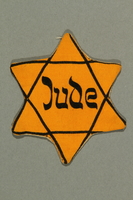
Factory-printed Star of David badge printed with Jude, belonging to a German Jewish woman
Object
Yellow, factory-printed Star of David badge stitched to a backing fabric by Selma Ansbacher and worn at all times by her daughter, Sigrid Ansbacher (later Strauss) in Frankfurt am Main, Germany, between September 1, 1941 and September 17, 1942. She began wearing the star after the September 1, 1941 decree that all Jews in the Reich six years of age or older were required to wear a yellow star badge. The badge was sewn onto outer clothing and used to stigmatize and control the Jewish population following Hitler’s rise to power in 1933 and the passage of the Nuremberg Laws in 1935. Before the war, Sigrid’s father, Ludwig, owned a fabric store in the small town of Dinkelsbühl, Germany, but eventually closed it and moved the family to Frankfurt in 1937. Sigrid’s oldest brother, Manfred, immigrated to Australia by 1939. In May 1942, Sigrid’s other brother, Heinz, was deported to Majdanek killing center in German-occupied Poland and was killed in August. Sigrid, her mother, Selma, and her father, Ludwig, were deported to Theresienstadt ghetto-labor camp in German-occupied Czechoslovakia in September 1942. Initially, Selma was assigned to work in the kitchens and later moved to the mica-splitting facility. In 1944, Sigrid was deported to a number of concentration camps where she performed forced labor, including: Auschwitz in German-occupied Poland, Kurzbach and Gross-Rosen in Germany, Mauthausen in Austria, and Bergen-Belsen in Germany, where she was liberated by British forces on April 15, 1945. Her parents, Selma and Ludwig, remained at Theresienstadt until the Soviet Army liberated the camp on May 9, 1945, and the couple moved back to Frankfurt. They immigrated to the United States in July 1946, where Sigrid joined them the following December.
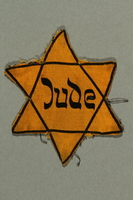
Factory-printed Star of David badge printed with Jude, belonging to a German Jewish woman
Object
Yellow, factory-printed Star of David badge stitched to a backing fabric by Selma Ansbacher and worn at all times in public by a family member in Frankfurt am Main, Germany after a September 1, 1941 decree that all Jews in the Reich six years of age or older were required to wear a yellow star badge. The star was sewn onto outer clothing and contributed to the stigmatization and control of the Jewish population following Hitler’s rise to power in 1933 and the passage of the Nuremberg Laws in 1935. Before the war, Selma’s husband, Ludwig, owned a fabric store in the small town of Dinkelsbühl, Germany, but eventually closed it and moved the family to Frankfurt in 1937. Selma’s oldest son, Manfred, immigrated to Australia by 1939. In May 1942, her other son, Heinz, was deported to Majdanek killing center in German-occupied Poland and was killed in August. Selma, her husband, Ludwig, and daughter, Sigrid, were deported to Theresienstadt ghetto-labor camp in German-occupied Czechoslovakia in September 1942. Initially, Selma worked as a group leader in the kitchen. She later worked in the mica-splitting facility, a job that contributed to the war effort, which she tried to use as leverage when Sigrid was assigned to a transport out of Theresienstadt. In 1944, Sigrid was deported to a number of concentration camps, including Auschwitz in German-occupied Poland and Bergen-Belsen in Germany, where she was liberated by British forces on April 15, 1945. Selma and Ludwig remained at Theresienstadt until the Soviet Army liberated the camp on May 9, 1945. The couple moved back to Frankfurt before immigrating to the United States in July 1946, where Sigrid joined them the following December.

Flake of mica collected from Theresienstadt by a German Jewish factory worker
Object
Thin flake of mica collected by Selma Ansbacher from the mica separation facility at Theresienstadt ghetto-labor camp, in German-occupied Czechoslovakia, where she was forced to work between fall 1942 and May 1945. During four 8-hour shifts, 250 women worked at a time at long tables and used specially designed flat knives to split the stone into paper-thin sheets for various industrial applications. In September 1942, Selma, her husband, Ludwig, and her daughter, Sigrid, were deported from Frankfurt, Germany to Theresienstadt. Initially, Selma worked as a group leader in the kitchen, peeling potatoes for soups. She became known as the “Potato Queen,” letting the women go each day without checking their pockets, allowing them to take home potatoes to supplement the meager rations. She later worked in the mica-splitting facility, a job that contributed to the war effort, which she tried to use as leverage when Sigrid was assigned to a transport out of Theresienstadt. Selma wrote a letter to the Central Secretariat, begging him to keep Sigrid off the transport. Her plea went unheeded, and Sigrid was deported to a number of concentration camps, including Bergen-Belsen in Germany, where she was liberated by British forces on April 15, 1945. Selma and Ludwig remained at Theresienstadt until the Soviet Army liberated the camp on May 9, 1945. The couple moved back to Frankfurt, Germany before immigrating to the United States in July 1946, where Sigrid joined them the following December.

Theresienstadt ghetto-labor camp scrip, 1 krone note, belonging to a German Jewish woman
Object
Scrip, valued at 1 krone, distributed to Selma Ansbacher and her family in Theresienstadt ghetto-labor camp in German-occupied Czechoslovakia between May 1943 and May 1945. At Theresienstadt, currency was confiscated from inmates and replaced with scrip, which could only be used in the camp. Before the war, Selma’s husband, Ludwig Ansbacher, owned a fabric store in the small town of Dinkelsbühl, Germany. In 1937 they moved to Frankfurt. They sent their oldest son Manfred to an agricultural school near Hanover and he immigrated to Australia by 1939. In May 1942, their son Heinz was deported to Majdanek killing center in German-occupied Poland and was killed in August. Selma, Ludwig, and their daughter Sigrid were deported to Theresienstadt ghetto-labor camp in German-occupied Czechoslovakia in September 1942. Initially, Selma worked as a group leader in the kitchen, peeling potatoes for soups. She later worked in the mica-splitting facility, a job that contributed to the war effort, which she tried to use as leverage when Sigrid was assigned to a transport out of Theresienstadt. In 1944, Sigrid was deported to a number of concentration camps, including Auschwitz in German-occupied Poland and Bergen-Belsen in Germany, where she was liberated by British forces on April 15, 1945. Selma and Ludwig remained at Theresienstadt until the Soviet Army liberated the camp on May 9, 1945. The couple moved back to Frankfurt before immigrating to the United States in July 1946, where Sigrid joined them the following December.
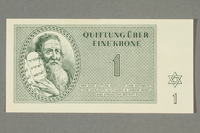
Theresienstadt ghetto-labor camp scrip, 1 krone note, belonging to a German Jewish woman
Object
Scrip, valued at 1 krone, distributed to Selma Ansbacher and her family in Theresienstadt ghetto-labor camp in German-occupied Czechoslovakia between May 1943 and May 1945. At Theresienstadt, currency was confiscated from inmates and replaced with scrip, which could only be used in the camp. Before the war, Selma’s husband, Ludwig Ansbacher, owned a fabric store in the small town of Dinkelsbühl, Germany. In 1937 they moved to Frankfurt. They sent their oldest son Manfred to an agricultural school near Hanover and he immigrated to Australia by 1939. In May 1942, their son Heinz was deported to Majdanek killing center in German-occupied Poland and was killed in August. Selma, Ludwig, and their daughter Sigrid were deported to Theresienstadt ghetto-labor camp in German-occupied Czechoslovakia in September 1942. Initially, Selma worked as a group leader in the kitchen, peeling potatoes for soups. She later worked in the mica-splitting facility, a job that contributed to the war effort, which she tried to use as leverage when Sigrid was assigned to a transport out of Theresienstadt. In 1944, Sigrid was deported to a number of concentration camps, including Auschwitz in German-occupied Poland and Bergen-Belsen in Germany, where she was liberated by British forces on April 15, 1945. Selma and Ludwig remained at Theresienstadt until the Soviet Army liberated the camp on May 9, 1945. The couple moved back to Frankfurt before immigrating to the United States in July 1946, where Sigrid joined them the following December.

Theresienstadt ghetto-labor camp scrip, 1 krone note, belonging to a German Jewish woman
Object
Scrip, valued at 1 krone, distributed to Selma Ansbacher and her family in Theresienstadt ghetto-labor camp in German-occupied Czechoslovakia between May 1943 and May 1945. At Theresienstadt, currency was confiscated from inmates and replaced with scrip, which could only be used in the camp. Before the war, Selma’s husband, Ludwig Ansbacher, owned a fabric store in the small town of Dinkelsbühl, Germany. In 1937 they moved to Frankfurt. They sent their oldest son Manfred to an agricultural school near Hanover and he immigrated to Australia by 1939. In May 1942, their son Heinz was deported to Majdanek killing center in German-occupied Poland and was killed in August. Selma, Ludwig, and their daughter Sigrid were deported to Theresienstadt ghetto-labor camp in German-occupied Czechoslovakia in September 1942. Initially, Selma worked as a group leader in the kitchen, peeling potatoes for soups. She later worked in the mica-splitting facility, a job that contributed to the war effort, which she tried to use as leverage when Sigrid was assigned to a transport out of Theresienstadt. In 1944, Sigrid was deported to a number of concentration camps, including Auschwitz in German-occupied Poland and Bergen-Belsen in Germany, where she was liberated by British forces on April 15, 1945. Selma and Ludwig remained at Theresienstadt until the Soviet Army liberated the camp on May 9, 1945. The couple moved back to Frankfurt before immigrating to the United States in July 1946, where Sigrid joined them the following December.

Theresienstadt ghetto-labor camp scrip, 1 krone note, belonging to a German Jewish woman
Object
Scrip, valued at 1 krone, distributed to Selma Ansbacher and her family in Theresienstadt ghetto-labor camp in German-occupied Czechoslovakia between May 1943 and May 1945. At Theresienstadt, currency was confiscated from inmates and replaced with scrip, which could only be used in the camp. Before the war, Selma’s husband, Ludwig Ansbacher, owned a fabric store in the small town of Dinkelsbühl, Germany. In 1937 they moved to Frankfurt. They sent their oldest son Manfred to an agricultural school near Hanover and he immigrated to Australia by 1939. In May 1942, their son Heinz was deported to Majdanek killing center in German-occupied Poland and was killed in August. Selma, Ludwig, and their daughter Sigrid were deported to Theresienstadt ghetto-labor camp in German-occupied Czechoslovakia in September 1942. Initially, Selma worked as a group leader in the kitchen, peeling potatoes for soups. She later worked in the mica-splitting facility, a job that contributed to the war effort, which she tried to use as leverage when Sigrid was assigned to a transport out of Theresienstadt. In 1944, Sigrid was deported to a number of concentration camps, including Auschwitz in German-occupied Poland and Bergen-Belsen in Germany, where she was liberated by British forces on April 15, 1945. Selma and Ludwig remained at Theresienstadt until the Soviet Army liberated the camp on May 9, 1945. The couple moved back to Frankfurt before immigrating to the United States in July 1946, where Sigrid joined them the following December.
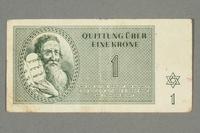
Theresienstadt ghetto-labor camp scrip, 1 krone note, belonging to a German Jewish woman
Object
Scrip, valued at 1 krone, distributed to Selma Ansbacher and her family in Theresienstadt ghetto-labor camp in German-occupied Czechoslovakia between May 1943 and May 1945. At Theresienstadt, currency was confiscated from inmates and replaced with scrip, which could only be used in the camp. Before the war, Selma’s husband, Ludwig Ansbacher, owned a fabric store in the small town of Dinkelsbühl, Germany. In 1937 they moved to Frankfurt. They sent their oldest son Manfred to an agricultural school near Hanover and he immigrated to Australia by 1939. In May 1942, their son Heinz was deported to Majdanek killing center in German-occupied Poland and was killed in August. Selma, Ludwig, and their daughter Sigrid were deported to Theresienstadt ghetto-labor camp in German-occupied Czechoslovakia in September 1942. Initially, Selma worked as a group leader in the kitchen, peeling potatoes for soups. She later worked in the mica-splitting facility, a job that contributed to the war effort, which she tried to use as leverage when Sigrid was assigned to a transport out of Theresienstadt. In 1944, Sigrid was deported to a number of concentration camps, including Auschwitz in German-occupied Poland and Bergen-Belsen in Germany, where she was liberated by British forces on April 15, 1945. Selma and Ludwig remained at Theresienstadt until the Soviet Army liberated the camp on May 9, 1945. The couple moved back to Frankfurt before immigrating to the United States in July 1946, where Sigrid joined them the following December.

Theresienstadt ghetto-labor camp scrip, 2 kronen note, belonging to a German Jewish woman
Object
Scrip, valued at 2 kronen, distributed to Selma Ansbacher and her family in Theresienstadt ghetto-labor camp in German-occupied Czechoslovakia between May 1943 and May 1945. At Theresienstadt, currency was confiscated from inmates and replaced with scrip, which could only be used in the camp. Before the war, Selma’s husband, Ludwig Ansbacher, owned a fabric store in the small town of Dinkelsbühl, Germany. In 1937 they moved to Frankfurt. They sent their oldest son Manfred to an agricultural school near Hanover and he immigrated to Australia by 1939. In May 1942, their son Heinz was deported to Majdanek killing center in German-occupied Poland and was killed in August. Selma, Ludwig, and their daughter Sigrid were deported to Theresienstadt ghetto-labor camp in German-occupied Czechoslovakia in September 1942. Initially, Selma worked as a group leader in the kitchen, peeling potatoes for soups. She later worked in the mica-splitting facility, a job that contributed to the war effort, which she tried to use as leverage when Sigrid was assigned to a transport out of Theresienstadt. In 1944, Sigrid was deported to a number of concentration camps, including Auschwitz in German-occupied Poland and Bergen-Belsen in Germany, where she was liberated by British forces on April 15, 1945. Selma and Ludwig remained at Theresienstadt until the Soviet Army liberated the camp on May 9, 1945. The couple moved back to Frankfurt before immigrating to the United States in July 1946, where Sigrid joined them the following December.

Theresienstadt ghetto-labor camp scrip, 2 kronen note, belonging to a German Jewish woman
Object
Scrip, valued at 2 kronen, distributed to Selma Ansbacher and her family in Theresienstadt ghetto-labor camp in German-occupied Czechoslovakia between May 1943 and May 1945. At Theresienstadt, currency was confiscated from inmates and replaced with scrip, which could only be used in the camp. Before the war, Selma’s husband, Ludwig Ansbacher, owned a fabric store in the small town of Dinkelsbühl, Germany. In 1937 they moved to Frankfurt. They sent their oldest son Manfred to an agricultural school near Hanover and he immigrated to Australia by 1939. In May 1942, their son Heinz was deported to Majdanek killing center in German-occupied Poland and was killed in August. Selma, Ludwig, and their daughter Sigrid were deported to Theresienstadt ghetto-labor camp in German-occupied Czechoslovakia in September 1942. Initially, Selma worked as a group leader in the kitchen, peeling potatoes for soups. She later worked in the mica-splitting facility, a job that contributed to the war effort, which she tried to use as leverage when Sigrid was assigned to a transport out of Theresienstadt. In 1944, Sigrid was deported to a number of concentration camps, including Auschwitz in German-occupied Poland and Bergen-Belsen in Germany, where she was liberated by British forces on April 15, 1945. Selma and Ludwig remained at Theresienstadt until the Soviet Army liberated the camp on May 9, 1945. The couple moved back to Frankfurt before immigrating to the United States in July 1946, where Sigrid joined them the following December.
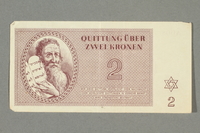
Theresienstadt ghetto-labor camp scrip, 2 kronen note, belonging to a German Jewish woman
Object
Scrip, valued at 2 kronen, distributed to Selma Ansbacher and her family in Theresienstadt ghetto-labor camp in German-occupied Czechoslovakia between May 1943 and May 1945. At Theresienstadt, currency was confiscated from inmates and replaced with scrip, which could only be used in the camp. Before the war, Selma’s husband, Ludwig Ansbacher, owned a fabric store in the small town of Dinkelsbühl, Germany. In 1937 they moved to Frankfurt. They sent their oldest son Manfred to an agricultural school near Hanover and he immigrated to Australia by 1939. In May 1942, their son Heinz was deported to Majdanek killing center in German-occupied Poland and was killed in August. Selma, Ludwig, and their daughter Sigrid were deported to Theresienstadt ghetto-labor camp in German-occupied Czechoslovakia in September 1942. Initially, Selma worked as a group leader in the kitchen, peeling potatoes for soups. She later worked in the mica-splitting facility, a job that contributed to the war effort, which she tried to use as leverage when Sigrid was assigned to a transport out of Theresienstadt. In 1944, Sigrid was deported to a number of concentration camps, including Auschwitz in German-occupied Poland and Bergen-Belsen in Germany, where she was liberated by British forces on April 15, 1945. Selma and Ludwig remained at Theresienstadt until the Soviet Army liberated the camp on May 9, 1945. The couple moved back to Frankfurt before immigrating to the United States in July 1946, where Sigrid joined them the following December.

Theresienstadt ghetto-labor camp scrip, 2 kronen note, belonging to a German Jewish woman
Object
Scrip, valued at 2 kronen, distributed to Selma Ansbacher and her family in Theresienstadt ghetto-labor camp in German-occupied Czechoslovakia between May 1943 and May 1945. At Theresienstadt, currency was confiscated from inmates and replaced with scrip, which could only be used in the camp. Before the war, Selma’s husband, Ludwig Ansbacher, owned a fabric store in the small town of Dinkelsbühl, Germany. In 1937 they moved to Frankfurt. They sent their oldest son Manfred to an agricultural school near Hanover and he immigrated to Australia by 1939. In May 1942, their son Heinz was deported to Majdanek killing center in German-occupied Poland and was killed in August. Selma, Ludwig, and their daughter Sigrid were deported to Theresienstadt ghetto-labor camp in German-occupied Czechoslovakia in September 1942. Initially, Selma worked as a group leader in the kitchen, peeling potatoes for soups. She later worked in the mica-splitting facility, a job that contributed to the war effort, which she tried to use as leverage when Sigrid was assigned to a transport out of Theresienstadt. In 1944, Sigrid was deported to a number of concentration camps, including Auschwitz in German-occupied Poland and Bergen-Belsen in Germany, where she was liberated by British forces on April 15, 1945. Selma and Ludwig remained at Theresienstadt until the Soviet Army liberated the camp on May 9, 1945. The couple moved back to Frankfurt before immigrating to the United States in July 1946, where Sigrid joined them the following December.
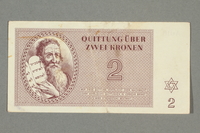
Theresienstadt ghetto-labor camp scrip, 2 kronen note, belonging to a German Jewish woman
Object
Scrip, valued at 2 kronen, distributed to Selma Ansbacher and her family in Theresienstadt ghetto-labor camp in German-occupied Czechoslovakia between May 1943 and May 1945. At Theresienstadt, currency was confiscated from inmates and replaced with scrip, which could only be used in the camp. Before the war, Selma’s husband, Ludwig Ansbacher, owned a fabric store in the small town of Dinkelsbühl, Germany. In 1937 they moved to Frankfurt. They sent their oldest son Manfred to an agricultural school near Hanover and he immigrated to Australia by 1939. In May 1942, their son Heinz was deported to Majdanek killing center in German-occupied Poland and was killed in August. Selma, Ludwig, and their daughter Sigrid were deported to Theresienstadt ghetto-labor camp in German-occupied Czechoslovakia in September 1942. Initially, Selma worked as a group leader in the kitchen, peeling potatoes for soups. She later worked in the mica-splitting facility, a job that contributed to the war effort, which she tried to use as leverage when Sigrid was assigned to a transport out of Theresienstadt. In 1944, Sigrid was deported to a number of concentration camps, including Auschwitz in German-occupied Poland and Bergen-Belsen in Germany, where she was liberated by British forces on April 15, 1945. Selma and Ludwig remained at Theresienstadt until the Soviet Army liberated the camp on May 9, 1945. The couple moved back to Frankfurt before immigrating to the United States in July 1946, where Sigrid joined them the following December.
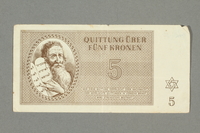
Theresienstadt ghetto-labor camp scrip, 5 kronen note, belonging to a German Jewish woman
Object
Scrip, valued at 5 kronen, distributed to Selma Ansbacher and her family in Theresienstadt ghetto-labor camp in German-occupied Czechoslovakia between May 1943 and May 1945. At Theresienstadt, currency was confiscated from inmates and replaced with scrip, which could only be used in the camp. Before the war, Selma’s husband, Ludwig Ansbacher, owned a fabric store in the small town of Dinkelsbühl, Germany. In 1937 they moved to Frankfurt. They sent their oldest son Manfred to an agricultural school near Hanover and he immigrated to Australia by 1939. In May 1942, their son Heinz was deported to Majdanek killing center in German-occupied Poland and was killed in August. Selma, Ludwig, and their daughter Sigrid were deported to Theresienstadt ghetto-labor camp in German-occupied Czechoslovakia in September 1942. Initially, Selma worked as a group leader in the kitchen, peeling potatoes for soups. She later worked in the mica-splitting facility, a job that contributed to the war effort, which she tried to use as leverage when Sigrid was assigned to a transport out of Theresienstadt. In 1944, Sigrid was deported to a number of concentration camps, including Auschwitz in German-occupied Poland and Bergen-Belsen in Germany, where she was liberated by British forces on April 15, 1945. Selma and Ludwig remained at Theresienstadt until the Soviet Army liberated the camp on May 9, 1945. The couple moved back to Frankfurt before immigrating to the United States in July 1946, where Sigrid joined them the following December.

Theresienstadt ghetto-labor camp scrip, 5 kronen note, belonging to a German Jewish woman
Object
Scrip, valued at 5 kronen, distributed to Selma Ansbacher and her family in Theresienstadt ghetto-labor camp in German-occupied Czechoslovakia between May 1943 and May 1945. At Theresienstadt, currency was confiscated from inmates and replaced with scrip, which could only be used in the camp. Before the war, Selma’s husband, Ludwig Ansbacher, owned a fabric store in the small town of Dinkelsbühl, Germany. In 1937 they moved to Frankfurt. They sent their oldest son Manfred to an agricultural school near Hanover and he immigrated to Australia by 1939. In May 1942, their son Heinz was deported to Majdanek killing center in German-occupied Poland and was killed in August. Selma, Ludwig, and their daughter Sigrid were deported to Theresienstadt ghetto-labor camp in German-occupied Czechoslovakia in September 1942. Initially, Selma worked as a group leader in the kitchen, peeling potatoes for soups. She later worked in the mica-splitting facility, a job that contributed to the war effort, which she tried to use as leverage when Sigrid was assigned to a transport out of Theresienstadt. In 1944, Sigrid was deported to a number of concentration camps, including Auschwitz in German-occupied Poland and Bergen-Belsen in Germany, where she was liberated by British forces on April 15, 1945. Selma and Ludwig remained at Theresienstadt until the Soviet Army liberated the camp on May 9, 1945. The couple moved back to Frankfurt before immigrating to the United States in July 1946, where Sigrid joined them the following December.

Theresienstadt ghetto-labor camp scrip, 5 kronen note, belonging to a German Jewish woman
Object
Scrip, valued at 5 kronen, distributed to Selma Ansbacher and her family in Theresienstadt ghetto-labor camp in German-occupied Czechoslovakia between May 1943 and May 1945. At Theresienstadt, currency was confiscated from inmates and replaced with scrip, which could only be used in the camp. Before the war, Selma’s husband, Ludwig Ansbacher, owned a fabric store in the small town of Dinkelsbühl, Germany. In 1937 they moved to Frankfurt. They sent their oldest son Manfred to an agricultural school near Hanover and he immigrated to Australia by 1939. In May 1942, their son Heinz was deported to Majdanek killing center in German-occupied Poland and was killed in August. Selma, Ludwig, and their daughter Sigrid were deported to Theresienstadt ghetto-labor camp in German-occupied Czechoslovakia in September 1942. Initially, Selma worked as a group leader in the kitchen, peeling potatoes for soups. She later worked in the mica-splitting facility, a job that contributed to the war effort, which she tried to use as leverage when Sigrid was assigned to a transport out of Theresienstadt. In 1944, Sigrid was deported to a number of concentration camps, including Auschwitz in German-occupied Poland and Bergen-Belsen in Germany, where she was liberated by British forces on April 15, 1945. Selma and Ludwig remained at Theresienstadt until the Soviet Army liberated the camp on May 9, 1945. The couple moved back to Frankfurt before immigrating to the United States in July 1946, where Sigrid joined them the following December.

Theresienstadt ghetto-labor camp scrip, 5 kronen note, belonging to a German Jewish woman
Object
Scrip, valued at 5 kronen, distributed to Selma Ansbacher and her family in Theresienstadt ghetto-labor camp in German-occupied Czechoslovakia between May 1943 and May 1945. At Theresienstadt, currency was confiscated from inmates and replaced with scrip, which could only be used in the camp. Before the war, Selma’s husband, Ludwig Ansbacher, owned a fabric store in the small town of Dinkelsbühl, Germany. In 1937 they moved to Frankfurt. They sent their oldest son Manfred to an agricultural school near Hanover and he immigrated to Australia by 1939. In May 1942, their son Heinz was deported to Majdanek killing center in German-occupied Poland and was killed in August. Selma, Ludwig, and their daughter Sigrid were deported to Theresienstadt ghetto-labor camp in German-occupied Czechoslovakia in September 1942. Initially, Selma worked as a group leader in the kitchen, peeling potatoes for soups. She later worked in the mica-splitting facility, a job that contributed to the war effort, which she tried to use as leverage when Sigrid was assigned to a transport out of Theresienstadt. In 1944, Sigrid was deported to a number of concentration camps, including Auschwitz in German-occupied Poland and Bergen-Belsen in Germany, where she was liberated by British forces on April 15, 1945. Selma and Ludwig remained at Theresienstadt until the Soviet Army liberated the camp on May 9, 1945. The couple moved back to Frankfurt before immigrating to the United States in July 1946, where Sigrid joined them the following December.
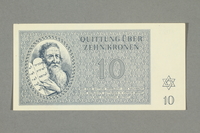
Theresienstadt ghetto-labor camp scrip, 10 kronen note, belonging to a German Jewish woman
Object
Scrip, valued at 10 kronen, distributed to Selma Ansbacher and her family in Theresienstadt ghetto-labor camp in German-occupied Czechoslovakia between May 1943 and May 1945. At Theresienstadt, currency was confiscated from inmates and replaced with scrip, which could only be used in the camp. Before the war, Selma’s husband, Ludwig Ansbacher, owned a fabric store in the small town of Dinkelsbühl, Germany. In 1937 they moved to Frankfurt. They sent their oldest son Manfred to an agricultural school near Hanover and he immigrated to Australia by 1939. In May 1942, their son Heinz was deported to Majdanek killing center in German-occupied Poland and was killed in August. Selma, Ludwig, and their daughter Sigrid were deported to Theresienstadt ghetto-labor camp in German-occupied Czechoslovakia in September 1942. Initially, Selma worked as a group leader in the kitchen, peeling potatoes for soups. She later worked in the mica-splitting facility, a job that contributed to the war effort, which she tried to use as leverage when Sigrid was assigned to a transport out of Theresienstadt. In 1944, Sigrid was deported to a number of concentration camps, including Auschwitz in German-occupied Poland and Bergen-Belsen in Germany, where she was liberated by British forces on April 15, 1945. Selma and Ludwig remained at Theresienstadt until the Soviet Army liberated the camp on May 9, 1945. The couple moved back to Frankfurt before immigrating to the United States in July 1946, where Sigrid joined them the following December.
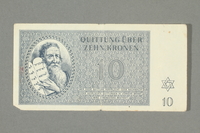
Theresienstadt ghetto-labor camp scrip, 10 kronen note, belonging to a German Jewish woman
Object
Scrip, valued at 10 kronen, distributed to Selma Ansbacher and her family in Theresienstadt ghetto-labor camp in German-occupied Czechoslovakia between May 1943 and May 1945. At Theresienstadt, currency was confiscated from inmates and replaced with scrip, which could only be used in the camp. Before the war, Selma’s husband, Ludwig Ansbacher, owned a fabric store in the small town of Dinkelsbühl, Germany. In 1937 they moved to Frankfurt. They sent their oldest son Manfred to an agricultural school near Hanover and he immigrated to Australia by 1939. In May 1942, their son Heinz was deported to Majdanek killing center in German-occupied Poland and was killed in August. Selma, Ludwig, and their daughter Sigrid were deported to Theresienstadt ghetto-labor camp in German-occupied Czechoslovakia in September 1942. Initially, Selma worked as a group leader in the kitchen, peeling potatoes for soups. She later worked in the mica-splitting facility, a job that contributed to the war effort, which she tried to use as leverage when Sigrid was assigned to a transport out of Theresienstadt. In 1944, Sigrid was deported to a number of concentration camps, including Auschwitz in German-occupied Poland and Bergen-Belsen in Germany, where she was liberated by British forces on April 15, 1945. Selma and Ludwig remained at Theresienstadt until the Soviet Army liberated the camp on May 9, 1945. The couple moved back to Frankfurt before immigrating to the United States in July 1946, where Sigrid joined them the following December.

Theresienstadt ghetto-labor camp scrip, 10 kronen note, belonging to a German Jewish woman
Object
Scrip, valued at 10 kronen, distributed to Selma Ansbacher and her family in Theresienstadt ghetto-labor camp in German-occupied Czechoslovakia between May 1943 and May 1945. At Theresienstadt, currency was confiscated from inmates and replaced with scrip, which could only be used in the camp. Before the war, Selma’s husband, Ludwig Ansbacher, owned a fabric store in the small town of Dinkelsbühl, Germany. In 1937 they moved to Frankfurt. They sent their oldest son Manfred to an agricultural school near Hanover and he immigrated to Australia by 1939. In May 1942, their son Heinz was deported to Majdanek killing center in German-occupied Poland and was killed in August. Selma, Ludwig, and their daughter Sigrid were deported to Theresienstadt ghetto-labor camp in German-occupied Czechoslovakia in September 1942. Initially, Selma worked as a group leader in the kitchen, peeling potatoes for soups. She later worked in the mica-splitting facility, a job that contributed to the war effort, which she tried to use as leverage when Sigrid was assigned to a transport out of Theresienstadt. In 1944, Sigrid was deported to a number of concentration camps, including Auschwitz in German-occupied Poland and Bergen-Belsen in Germany, where she was liberated by British forces on April 15, 1945. Selma and Ludwig remained at Theresienstadt until the Soviet Army liberated the camp on May 9, 1945. The couple moved back to Frankfurt before immigrating to the United States in July 1946, where Sigrid joined them the following December.
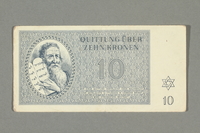
Theresienstadt ghetto-labor camp scrip, 10 kronen note, belonging to a German Jewish woman
Object
Scrip, valued at 10 kronen, distributed to Selma Ansbacher and her family in Theresienstadt ghetto-labor camp in German-occupied Czechoslovakia between May 1943 and May 1945. At Theresienstadt, currency was confiscated from inmates and replaced with scrip, which could only be used in the camp. Before the war, Selma’s husband, Ludwig Ansbacher, owned a fabric store in the small town of Dinkelsbühl, Germany. In 1937 they moved to Frankfurt. They sent their oldest son Manfred to an agricultural school near Hanover and he immigrated to Australia by 1939. In May 1942, their son Heinz was deported to Majdanek killing center in German-occupied Poland and was killed in August. Selma, Ludwig, and their daughter Sigrid were deported to Theresienstadt ghetto-labor camp in German-occupied Czechoslovakia in September 1942. Initially, Selma worked as a group leader in the kitchen, peeling potatoes for soups. She later worked in the mica-splitting facility, a job that contributed to the war effort, which she tried to use as leverage when Sigrid was assigned to a transport out of Theresienstadt. In 1944, Sigrid was deported to a number of concentration camps, including Auschwitz in German-occupied Poland and Bergen-Belsen in Germany, where she was liberated by British forces on April 15, 1945. Selma and Ludwig remained at Theresienstadt until the Soviet Army liberated the camp on May 9, 1945. The couple moved back to Frankfurt before immigrating to the United States in July 1946, where Sigrid joined them the following December.
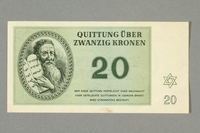
Theresienstadt ghetto-labor camp scrip, 20 kronen note, belonging to a German Jewish woman
Object
Scrip, valued at 20 kronen, distributed to Selma Ansbacher and her family in Theresienstadt ghetto-labor camp in German-occupied Czechoslovakia between May 1943 and May 1945. At Theresienstadt, currency was confiscated from inmates and replaced with scrip, which could only be used in the camp. Before the war, Selma’s husband, Ludwig Ansbacher, owned a fabric store in the small town of Dinkelsbühl, Germany. In 1937 they moved to Frankfurt. They sent their oldest son Manfred to an agricultural school near Hanover and he immigrated to Australia by 1939. In May 1942, their son Heinz was deported to Majdanek killing center in German-occupied Poland and was killed in August. Selma, Ludwig, and their daughter Sigrid were deported to Theresienstadt ghetto-labor camp in German-occupied Czechoslovakia in September 1942. Initially, Selma worked as a group leader in the kitchen, peeling potatoes for soups. She later worked in the mica-splitting facility, a job that contributed to the war effort, which she tried to use as leverage when Sigrid was assigned to a transport out of Theresienstadt. In 1944, Sigrid was deported to a number of concentration camps, including Auschwitz in German-occupied Poland and Bergen-Belsen in Germany, where she was liberated by British forces on April 15, 1945. Selma and Ludwig remained at Theresienstadt until the Soviet Army liberated the camp on May 9, 1945. The couple moved back to Frankfurt before immigrating to the United States in July 1946, where Sigrid joined them the following December.
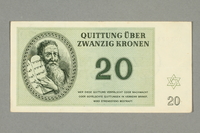
Theresienstadt ghetto-labor camp scrip, 20 kronen note, belonging to a German Jewish woman
Object
Scrip, valued at 20 kronen, distributed to Selma Ansbacher and her family in Theresienstadt ghetto-labor camp in German-occupied Czechoslovakia between May 1943 and May 1945. At Theresienstadt, currency was confiscated from inmates and replaced with scrip, which could only be used in the camp. Before the war, Selma’s husband, Ludwig Ansbacher, owned a fabric store in the small town of Dinkelsbühl, Germany. In 1937 they moved to Frankfurt. They sent their oldest son Manfred to an agricultural school near Hanover and he immigrated to Australia by 1939. In May 1942, their son Heinz was deported to Majdanek killing center in German-occupied Poland and was killed in August. Selma, Ludwig, and their daughter Sigrid were deported to Theresienstadt ghetto-labor camp in German-occupied Czechoslovakia in September 1942. Initially, Selma worked as a group leader in the kitchen, peeling potatoes for soups. She later worked in the mica-splitting facility, a job that contributed to the war effort, which she tried to use as leverage when Sigrid was assigned to a transport out of Theresienstadt. In 1944, Sigrid was deported to a number of concentration camps, including Auschwitz in German-occupied Poland and Bergen-Belsen in Germany, where she was liberated by British forces on April 15, 1945. Selma and Ludwig remained at Theresienstadt until the Soviet Army liberated the camp on May 9, 1945. The couple moved back to Frankfurt before immigrating to the United States in July 1946, where Sigrid joined them the following December.
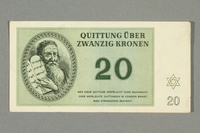
Theresienstadt ghetto-labor camp scrip, 20 kronen note, belonging to a German Jewish woman
Object
Scrip, valued at 20 kronen, distributed to Selma Ansbacher and her family in Theresienstadt ghetto-labor camp in German-occupied Czechoslovakia between May 1943 and May 1945. At Theresienstadt, currency was confiscated from inmates and replaced with scrip, which could only be used in the camp. Before the war, Selma’s husband, Ludwig Ansbacher, owned a fabric store in the small town of Dinkelsbühl, Germany. In 1937 they moved to Frankfurt. They sent their oldest son Manfred to an agricultural school near Hanover and he immigrated to Australia by 1939. In May 1942, their son Heinz was deported to Majdanek killing center in German-occupied Poland and was killed in August. Selma, Ludwig, and their daughter Sigrid were deported to Theresienstadt ghetto-labor camp in German-occupied Czechoslovakia in September 1942. Initially, Selma worked as a group leader in the kitchen, peeling potatoes for soups. She later worked in the mica-splitting facility, a job that contributed to the war effort, which she tried to use as leverage when Sigrid was assigned to a transport out of Theresienstadt. In 1944, Sigrid was deported to a number of concentration camps, including Auschwitz in German-occupied Poland and Bergen-Belsen in Germany, where she was liberated by British forces on April 15, 1945. Selma and Ludwig remained at Theresienstadt until the Soviet Army liberated the camp on May 9, 1945. The couple moved back to Frankfurt before immigrating to the United States in July 1946, where Sigrid joined them the following December.
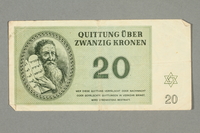
Theresienstadt ghetto-labor camp scrip, 20 kronen note, belonging to a German Jewish woman
Object
Scrip, valued at 20 kronen, distributed to Selma Ansbacher and her family in Theresienstadt ghetto-labor camp in German-occupied Czechoslovakia between May 1943 and May 1945. At Theresienstadt, currency was confiscated from inmates and replaced with scrip, which could only be used in the camp. Before the war, Selma’s husband, Ludwig Ansbacher, owned a fabric store in the small town of Dinkelsbühl, Germany. In 1937 they moved to Frankfurt. They sent their oldest son Manfred to an agricultural school near Hanover and he immigrated to Australia by 1939. In May 1942, their son Heinz was deported to Majdanek killing center in German-occupied Poland and was killed in August. Selma, Ludwig, and their daughter Sigrid were deported to Theresienstadt ghetto-labor camp in German-occupied Czechoslovakia in September 1942. Initially, Selma worked as a group leader in the kitchen, peeling potatoes for soups. She later worked in the mica-splitting facility, a job that contributed to the war effort, which she tried to use as leverage when Sigrid was assigned to a transport out of Theresienstadt. In 1944, Sigrid was deported to a number of concentration camps, including Auschwitz in German-occupied Poland and Bergen-Belsen in Germany, where she was liberated by British forces on April 15, 1945. Selma and Ludwig remained at Theresienstadt until the Soviet Army liberated the camp on May 9, 1945. The couple moved back to Frankfurt before immigrating to the United States in July 1946, where Sigrid joined them the following December.

Theresienstadt ghetto-labor camp scrip, 20 kronen note, belonging to a German Jewish woman
Object
Scrip, valued at 20 kronen, distributed to Selma Ansbacher and her family in Theresienstadt ghetto-labor camp in German-occupied Czechoslovakia between May 1943 and May 1945. At Theresienstadt, currency was confiscated from inmates and replaced with scrip, which could only be used in the camp. Before the war, Selma’s husband, Ludwig Ansbacher, owned a fabric store in the small town of Dinkelsbühl, Germany. In 1937 they moved to Frankfurt. They sent their oldest son Manfred to an agricultural school near Hanover and he immigrated to Australia by 1939. In May 1942, their son Heinz was deported to Majdanek killing center in German-occupied Poland and was killed in August. Selma, Ludwig, and their daughter Sigrid were deported to Theresienstadt ghetto-labor camp in German-occupied Czechoslovakia in September 1942. Initially, Selma worked as a group leader in the kitchen, peeling potatoes for soups. She later worked in the mica-splitting facility, a job that contributed to the war effort, which she tried to use as leverage when Sigrid was assigned to a transport out of Theresienstadt. In 1944, Sigrid was deported to a number of concentration camps, including Auschwitz in German-occupied Poland and Bergen-Belsen in Germany, where she was liberated by British forces on April 15, 1945. Selma and Ludwig remained at Theresienstadt until the Soviet Army liberated the camp on May 9, 1945. The couple moved back to Frankfurt before immigrating to the United States in July 1946, where Sigrid joined them the following December.

Theresienstadt ghetto-labor camp scrip, 50 kronen note, belonging to a German Jewish woman
Object
Scrip, valued at 50 kronen, distributed to Selma Ansbacher and her family in Theresienstadt ghetto-labor camp in German-occupied Czechoslovakia between May 1943 and May 1945. At Theresienstadt, currency was confiscated from inmates and replaced with scrip, which could only be used in the camp. Before the war, Selma’s husband, Ludwig Ansbacher, owned a fabric store in the small town of Dinkelsbühl, Germany. In 1937 they moved to Frankfurt. They sent their oldest son Manfred to an agricultural school near Hanover and he immigrated to Australia by 1939. In May 1942, their son Heinz was deported to Majdanek killing center in German-occupied Poland and was killed in August. Selma, Ludwig, and their daughter Sigrid were deported to Theresienstadt ghetto-labor camp in German-occupied Czechoslovakia in September 1942. Initially, Selma worked as a group leader in the kitchen, peeling potatoes for soups. She later worked in the mica-splitting facility, a job that contributed to the war effort, which she tried to use as leverage when Sigrid was assigned to a transport out of Theresienstadt. In 1944, Sigrid was deported to a number of concentration camps, including Auschwitz in German-occupied Poland and Bergen-Belsen in Germany, where she was liberated by British forces on April 15, 1945. Selma and Ludwig remained at Theresienstadt until the Soviet Army liberated the camp on May 9, 1945. The couple moved back to Frankfurt before immigrating to the United States in July 1946, where Sigrid joined them the following December.

Theresienstadt ghetto-labor camp scrip, 50 kronen note, belonging to a German Jewish woman
Object
Scrip, valued at 50 kronen, distributed to Selma Ansbacher and her family in Theresienstadt ghetto-labor camp in German-occupied Czechoslovakia between May 1943 and May 1945. At Theresienstadt, currency was confiscated from inmates and replaced with scrip, which could only be used in the camp. Before the war, Selma’s husband, Ludwig Ansbacher, owned a fabric store in the small town of Dinkelsbühl, Germany. In 1937 they moved to Frankfurt. They sent their oldest son Manfred to an agricultural school near Hanover and he immigrated to Australia by 1939. In May 1942, their son Heinz was deported to Majdanek killing center in German-occupied Poland and was killed in August. Selma, Ludwig, and their daughter Sigrid were deported to Theresienstadt ghetto-labor camp in German-occupied Czechoslovakia in September 1942. Initially, Selma worked as a group leader in the kitchen, peeling potatoes for soups. She later worked in the mica-splitting facility, a job that contributed to the war effort, which she tried to use as leverage when Sigrid was assigned to a transport out of Theresienstadt. In 1944, Sigrid was deported to a number of concentration camps, including Auschwitz in German-occupied Poland and Bergen-Belsen in Germany, where she was liberated by British forces on April 15, 1945. Selma and Ludwig remained at Theresienstadt until the Soviet Army liberated the camp on May 9, 1945. The couple moved back to Frankfurt before immigrating to the United States in July 1946, where Sigrid joined them the following December.

Theresienstadt ghetto-labor camp scrip, 50 kronen note, belonging to a German Jewish woman
Object
Scrip, valued at 50 kronen, distributed to Selma Ansbacher and her family in Theresienstadt ghetto-labor camp in German-occupied Czechoslovakia between May 1943 and May 1945. At Theresienstadt, currency was confiscated from inmates and replaced with scrip, which could only be used in the camp. Before the war, Selma’s husband, Ludwig Ansbacher, owned a fabric store in the small town of Dinkelsbühl, Germany. In 1937 they moved to Frankfurt. They sent their oldest son Manfred to an agricultural school near Hanover and he immigrated to Australia by 1939. In May 1942, their son Heinz was deported to Majdanek killing center in German-occupied Poland and was killed in August. Selma, Ludwig, and their daughter Sigrid were deported to Theresienstadt ghetto-labor camp in German-occupied Czechoslovakia in September 1942. Initially, Selma worked as a group leader in the kitchen, peeling potatoes for soups. She later worked in the mica-splitting facility, a job that contributed to the war effort, which she tried to use as leverage when Sigrid was assigned to a transport out of Theresienstadt. In 1944, Sigrid was deported to a number of concentration camps, including Auschwitz in German-occupied Poland and Bergen-Belsen in Germany, where she was liberated by British forces on April 15, 1945. Selma and Ludwig remained at Theresienstadt until the Soviet Army liberated the camp on May 9, 1945. The couple moved back to Frankfurt before immigrating to the United States in July 1946, where Sigrid joined them the following December.
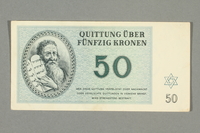
Theresienstadt ghetto-labor camp scrip, 50 kronen note, belonging to a German Jewish woman
Object
Scrip, valued at 50 kronen, distributed to Selma Ansbacher and her family in Theresienstadt ghetto-labor camp in German-occupied Czechoslovakia between May 1943 and May 1945. At Theresienstadt, currency was confiscated from inmates and replaced with scrip, which could only be used in the camp. Before the war, Selma’s husband, Ludwig Ansbacher, owned a fabric store in the small town of Dinkelsbühl, Germany. In 1937 they moved to Frankfurt. They sent their oldest son Manfred to an agricultural school near Hanover and he immigrated to Australia by 1939. In May 1942, their son Heinz was deported to Majdanek killing center in German-occupied Poland and was killed in August. Selma, Ludwig, and their daughter Sigrid were deported to Theresienstadt ghetto-labor camp in German-occupied Czechoslovakia in September 1942. Initially, Selma worked as a group leader in the kitchen, peeling potatoes for soups. She later worked in the mica-splitting facility, a job that contributed to the war effort, which she tried to use as leverage when Sigrid was assigned to a transport out of Theresienstadt. In 1944, Sigrid was deported to a number of concentration camps, including Auschwitz in German-occupied Poland and Bergen-Belsen in Germany, where she was liberated by British forces on April 15, 1945. Selma and Ludwig remained at Theresienstadt until the Soviet Army liberated the camp on May 9, 1945. The couple moved back to Frankfurt before immigrating to the United States in July 1946, where Sigrid joined them the following December.

Theresienstadt ghetto-labor camp scrip, 100 kronen note, belonging to a German Jewish woman
Object
Scrip, valued at 100 kronen, distributed to Selma Ansbacher and her family in Theresienstadt ghetto-labor camp in German-occupied Czechoslovakia between May 1943 and May 1945. At Theresienstadt, currency was confiscated from inmates and replaced with scrip, which could only be used in the camp. Before the war, Selma’s husband, Ludwig Ansbacher, owned a fabric store in the small town of Dinkelsbühl, Germany. In 1937 they moved to Frankfurt. They sent their oldest son Manfred to an agricultural school near Hanover and he immigrated to Australia by 1939. In May 1942, their son Heinz was deported to Majdanek killing center in German-occupied Poland and was killed in August. Selma, Ludwig, and their daughter Sigrid were deported to Theresienstadt ghetto-labor camp in German-occupied Czechoslovakia in September 1942. Initially, Selma worked as a group leader in the kitchen, peeling potatoes for soups. She later worked in the mica-splitting facility, a job that contributed to the war effort, which she tried to use as leverage when Sigrid was assigned to a transport out of Theresienstadt. In 1944, Sigrid was deported to a number of concentration camps, including Auschwitz in German-occupied Poland and Bergen-Belsen in Germany, where she was liberated by British forces on April 15, 1945. Selma and Ludwig remained at Theresienstadt until the Soviet Army liberated the camp on May 9, 1945. The couple moved back to Frankfurt before immigrating to the United States in July 1946, where Sigrid joined them the following December.
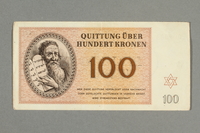
Theresienstadt ghetto-labor camp scrip, 100 kronen note, belonging to a German Jewish woman
Object
Scrip, valued at 100 kronen, distributed to Selma Ansbacher and her family in Theresienstadt ghetto-labor camp in German-occupied Czechoslovakia between May 1943 and May 1945. At Theresienstadt, currency was confiscated from inmates and replaced with scrip, which could only be used in the camp. Before the war, Selma’s husband, Ludwig Ansbacher, owned a fabric store in the small town of Dinkelsbühl, Germany. In 1937 they moved to Frankfurt. They sent their oldest son Manfred to an agricultural school near Hanover and he immigrated to Australia by 1939. In May 1942, their son Heinz was deported to Majdanek killing center in German-occupied Poland and was killed in August. Selma, Ludwig, and their daughter Sigrid were deported to Theresienstadt ghetto-labor camp in German-occupied Czechoslovakia in September 1942. Initially, Selma worked as a group leader in the kitchen, peeling potatoes for soups. She later worked in the mica-splitting facility, a job that contributed to the war effort, which she tried to use as leverage when Sigrid was assigned to a transport out of Theresienstadt. In 1944, Sigrid was deported to a number of concentration camps, including Auschwitz in German-occupied Poland and Bergen-Belsen in Germany, where she was liberated by British forces on April 15, 1945. Selma and Ludwig remained at Theresienstadt until the Soviet Army liberated the camp on May 9, 1945. The couple moved back to Frankfurt before immigrating to the United States in July 1946, where Sigrid joined them the following December.

Theresienstadt ghetto-labor camp scrip, 100 kronen note, belonging to a German Jewish woman
Object
Scrip, valued at 100 kronen, distributed to Selma Ansbacher and her family in Theresienstadt ghetto-labor camp in German-occupied Czechoslovakia between May 1943 and May 1945. At Theresienstadt, currency was confiscated from inmates and replaced with scrip, which could only be used in the camp. Before the war, Selma’s husband, Ludwig Ansbacher, owned a fabric store in the small town of Dinkelsbühl, Germany. In 1937 they moved to Frankfurt. They sent their oldest son Manfred to an agricultural school near Hanover and he immigrated to Australia by 1939. In May 1942, their son Heinz was deported to Majdanek killing center in German-occupied Poland and was killed in August. Selma, Ludwig, and their daughter Sigrid were deported to Theresienstadt ghetto-labor camp in German-occupied Czechoslovakia in September 1942. Initially, Selma worked as a group leader in the kitchen, peeling potatoes for soups. She later worked in the mica-splitting facility, a job that contributed to the war effort, which she tried to use as leverage when Sigrid was assigned to a transport out of Theresienstadt. In 1944, Sigrid was deported to a number of concentration camps, including Auschwitz in German-occupied Poland and Bergen-Belsen in Germany, where she was liberated by British forces on April 15, 1945. Selma and Ludwig remained at Theresienstadt until the Soviet Army liberated the camp on May 9, 1945. The couple moved back to Frankfurt before immigrating to the United States in July 1946, where Sigrid joined them the following December.
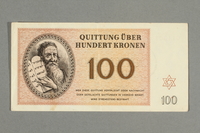
Theresienstadt ghetto-labor camp scrip, 100 kronen note, belonging to a German Jewish woman
Object
Scrip, valued at 100 kronen, distributed to Selma Ansbacher and her family in Theresienstadt ghetto-labor camp in German-occupied Czechoslovakia between May 1943 and May 1945. At Theresienstadt, currency was confiscated from inmates and replaced with scrip, which could only be used in the camp. Before the war, Selma’s husband, Ludwig Ansbacher, owned a fabric store in the small town of Dinkelsbühl, Germany. In 1937 they moved to Frankfurt. They sent their oldest son Manfred to an agricultural school near Hanover and he immigrated to Australia by 1939. In May 1942, their son Heinz was deported to Majdanek killing center in German-occupied Poland and was killed in August. Selma, Ludwig, and their daughter Sigrid were deported to Theresienstadt ghetto-labor camp in German-occupied Czechoslovakia in September 1942. Initially, Selma worked as a group leader in the kitchen, peeling potatoes for soups. She later worked in the mica-splitting facility, a job that contributed to the war effort, which she tried to use as leverage when Sigrid was assigned to a transport out of Theresienstadt. In 1944, Sigrid was deported to a number of concentration camps, including Auschwitz in German-occupied Poland and Bergen-Belsen in Germany, where she was liberated by British forces on April 15, 1945. Selma and Ludwig remained at Theresienstadt until the Soviet Army liberated the camp on May 9, 1945. The couple moved back to Frankfurt before immigrating to the United States in July 1946, where Sigrid joined them the following December.



